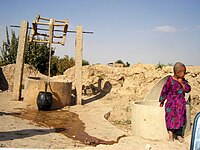
Photo from wikipedia
Abstract The pressure-driven electro-dewatering (EDW) of sewage sludge was assessed using a lab device. The sludge samples were supplied from four different Wastewater Treatment Plants (WWTPs) around the metropolitan area… Click to show full abstract
Abstract The pressure-driven electro-dewatering (EDW) of sewage sludge was assessed using a lab device. The sludge samples were supplied from four different Wastewater Treatment Plants (WWTPs) around the metropolitan area of Milan (Italy), including both aerobically and anaerobically stabilised samples. The test results show that the EDW treatment enabled to dewater the sludge samples to a dry solids content of 18.4–31.1% (wt%), which means 2.0–12.7% improvement as compared to the conventional mechanical dewatering treatment used in these WWTPs. A follow-up test was carried out with the sample giving the best dewatering performance. A dry solids content of 39.3% (wt%) was achieved. Apart from the technological performance, the economic feasibility of EDW was evaluated. The energy consumption and sludge treatment cost associated with the EDW process were compared with the reference case (the corresponding WWTP currently operating with mechanical dewatering line). It was found that for the best performance case, technology upgrade from the conventional mechanical dewatering to the EDW dewatering will enable the WWTP to reduce its sludge management cost up to 35% per year.
Journal Title: Journal of environmental chemical engineering
Year Published: 2017
Link to full text (if available)
Share on Social Media: Sign Up to like & get
recommendations!